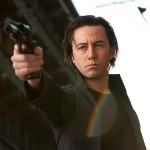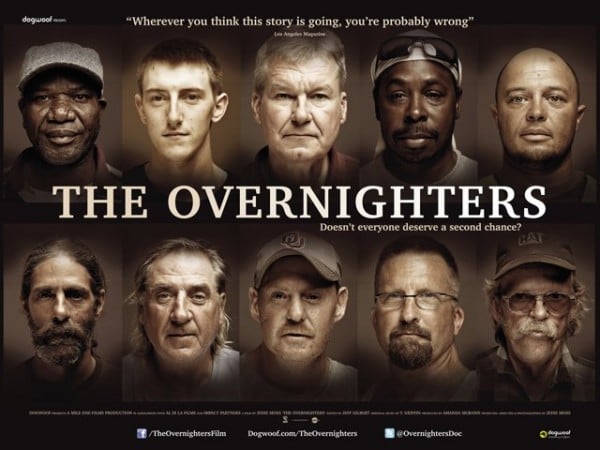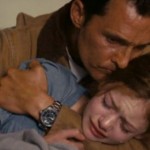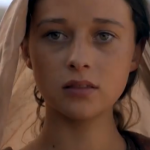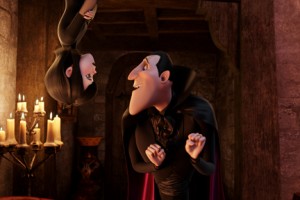 The first in the series of animated Halloween movies for kids, Hotel Transylvania trades on lite creepy crawly humor, but has a much more questionable subtext.
The first in the series of animated Halloween movies for kids, Hotel Transylvania trades on lite creepy crawly humor, but has a much more questionable subtext.
Count Dracula (voice of Adam Sandler, who also executive-produced) lives in the modern age far from the judgmental and intolerant eye of human beings. In fact, he has created a refuge high in the Transylvania hills for monsters of all shapes, sizes, and non-shapes. His resort offers all the amenities: zombies as bellhops to slowly meet your every need, a slime-filled pool, and activities to keep you occupied until the burning sun rises. Plus, the touchy French chef Quasimodo (who knew he could cook?) and his Rataouille-esqe rat companion will whip up the best in fake blood, worm cakes, or putrid omelets.
It’s Paradise for the undead set.
They’ve all moved in. Frankenstein (Kevin James) is in residence with his bride (Fran Descher). The wolfman (Steve Buscemi) has taken rooms with his fertile wolfwife (Molly Shannon) and extensive litter of little were-hooligans. The Invisible Man (David Spade) lurks around, or at least we think he does. Add in a mummy (Cee Lo Green), assorted gremlins, and a honeymooning skeleton couple and you have a veritable who-who of the undead.
But Mavis (Selena Gomez) wants more. Just reaching her adulthood at 118, she’s Dracula’s cherished daughter with his beloved departed wife. (Really departed, not undead or semi-dead or eternally living with no soul, but gone, kaput, truly killed at the hands of humans.)
Mavis wants to see the world, especially a place called Hawaii. Her father thinks the world is not safe for her. But humanity comes knocking in the form of a laid-back hiker dude named Jonathan (Andy Samberg).
That’s the setup, such as it is. There are some cute, creepy gags that get laughs. Sassy, vocal shrunken heads pay the part of “Do Not Disturb” doortags, always with an opinion on what is going on inside the room. Undead greats such as Beetoven show up in employ of the hotel. The best is the Invisible Man as he does things like attempt to play charades with only his hornrimmed glasses bobbing up and down with his invisible gestures.
Rated PG, the movie is about as scary as your neighbor’s Halloween display, the cartoony, fun neighbor, not the maniac with the scary sounds, fog machine, and axe a little too handy. An occasional mildly sexual joke does get through: the guests on their honeymoon, the skeleton who screams “Get your hand out of my wife!” and the invisible man making his hind quarters visible with the help of baby powder. Juvenile, but still slightly annoying.
More annoying, however, if it weren’t so boring and preachy, is the strained metaphor that sustains the movie and makes it a crusade for the forces of “tolerance.” The monsters take refuge from a world that can not accept them, creating a world for themselves. Their memories are full of pitchforks, torches, and screaming human mobs. Jonathan tries to convince Dracula that the world has moved on, but Dracula asks him to promise that if he “came out in the open right now,” everyone would accept him. Jonathan cannot.
The obvious subtext is the gay rights movement, but it could also be about African-Americans forced to take refuge from white society, Muslims in America, Conservative Christians versus the mainstream, or people who dedicate their lives to playing World of Warcraft while everyone else is becoming productive members of society.
The message is clear: No pitchforks. People who resist (whatever) are evil and mean and we should just tolerate the difference among us.
It’s the new morality preached to children.
At the risk of overthinking a stupid kids’ movie, let’s unpack this, shall we?
With the exception of Frankenstein (who should correctly be called Frankenstein’s monster, but we won’t quibble), the monsters represented have long histories of being metaphors for evil.
Dracula and vampires in general, with apologies to Twilight, are a metaphor for carnal hungers that consume a man and make him a threat to innocence, especially sexual hungers. Child molesters and sexual predators are not so far removed from vampires that drain the vitality from their victims.
Werewolves represent the rage and bloodlust of humanity, especially men, that turns them from rational creatures to marauding horrors without reason. The Hulk would be the same thing.
Mummies and skeletons and zombies embody our ancient dread of death, but also represent a soulless, relentless evil that is unyielding in its pursuit of its goals.
And the Invisible Man is about fear of new technology, especially in the hands of someone who would use it for murder and mayhem. Frankenstein’s monster is somewhat the same, although the real monster, we all know, is his creator, not the creation.
The motivation each or of these creatures (except Frankenstein’s monster) is evil. Well worth a few pitchforks and torches.
Even in the context of this kids’ movie, it’s unclear if the assembled monsters were ever killers of people. Dracula now drinks synthetic blood, but did he always? A murder three hundred years ago is still murder.
The movie sidesteps all this. Humanity is irrational in its former condemnation of monsters. Can’t we all just get along?
The problem, of course, is that evil does exist and must not be tolerated. Instead of teaching children tolerance at all costs, they should be learning to recognize and resist evil, be kind to those who are merely different, and protect those who are weaker than themselves. It’s a complicated world out there.
Kids need to be taught discernment, wisdom, and old fashioned work rather than the simplistic message “tolerate.” Movies like Spiderman, The Avengers, Finding Nemo, or The Lion King have these elements.
They make Hotel Transylvania look downright lazy.


